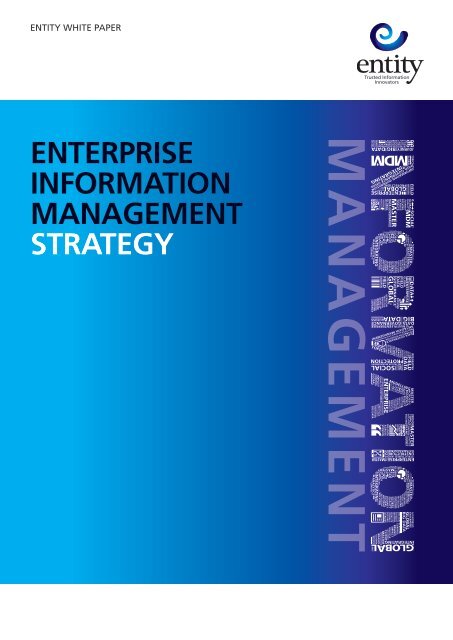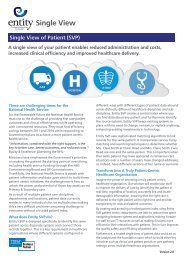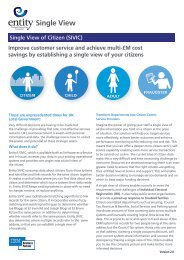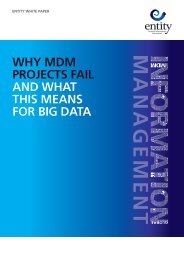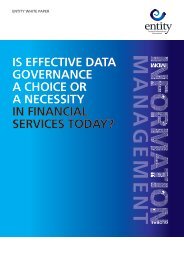ENT_IM_SHEET
You also want an ePaper? Increase the reach of your titles
YUMPU automatically turns print PDFs into web optimized ePapers that Google loves.
<strong>ENT</strong>ITY WHITE PAPER<br />
<strong>ENT</strong>ERPRISE<br />
INFORMATION<br />
MANAGEM<strong>ENT</strong><br />
STRATEGY
<strong>ENT</strong>ITY WHITE PAPER<br />
<strong>ENT</strong>ITY GROUP ADVISORY SERVICES<br />
<strong>ENT</strong>ERPRISE INFORMATION<br />
MANAGEM<strong>ENT</strong> STRATEGY<br />
IS INFORMATION WORKING FOR YOU?<br />
“The most<br />
meaningful way to<br />
differentiate your<br />
company from the<br />
competition, the best<br />
way to put distance<br />
between you and the<br />
crowd, is to do an<br />
outstanding job with<br />
information. How you<br />
gather, manage and<br />
use information will<br />
determine whether<br />
you win or lose.”<br />
Bill Gates<br />
You have probably invested significant amounts of time, money<br />
and energy in IT over the course of many years. Individually all the<br />
various systems appear to be operating largely as designed, but<br />
you know that the management information you receive presents<br />
an incomplete and inaccurate picture of your organisation.<br />
Working with some of the world’s largest public and private organisations, our experience<br />
shows that the problem is a lack of coordinated information management. Key business<br />
data is collected, processed and held within departmental silos, often serving a specific local<br />
purpose and process, but cannot then support the wider information needs of the business.<br />
Trying to bring data together at a higher level reveals errors, gaps and duplications, and<br />
informed decision-making based is almost impossible. Sound familiar?<br />
Organisations are now recognising that their data must be managed as an enterprise<br />
asset. They understand the need to weave information management strategies, policies,<br />
procedures and solutions throughout the fabric of their operation so that raw data becomes<br />
timely, relevant and actionable information.<br />
Entity’s two stage approach can help you establish the enterprise information management<br />
(E<strong>IM</strong>) solution to best support your strategic objectives.<br />
NS<br />
2
MANAG<br />
<strong>ENT</strong>ITY GROUP ADVISORY SERVICES<br />
<strong>ENT</strong>ITY WHITE PAPER<br />
STAGE ONE - ‐<strong>IM</strong> REVIEW<br />
The success of an E<strong>IM</strong> solution will usually involve affecting change throughout the<br />
organisation. This depends on establishing a clear vision of how the organisation already<br />
uses and manages information and providing a baseline that informs the design of the<br />
desired target state. In Stage One, Entity’s Information Management (<strong>IM</strong>) Review defines<br />
the existing baseline position and the target state.<br />
Baseline<br />
The old adage was<br />
never truer. Garbage<br />
Big Data In, Garbage<br />
Big Data Out.”<br />
Chris Finlay,<br />
Chairman,<br />
Entity Group<br />
To determine the baseline position, Entity’s consultants examine the organisation from a number<br />
of viewpoints.<br />
Executive View<br />
Working closely with your senior executives, initially the focus centres on the organisation’s vision<br />
and objectives to determine a set of goals for the E<strong>IM</strong> solution that are aligned with the overall<br />
strategic direction. Through a series of interviews, many other dimensions are considered such as<br />
the strength of executive sponsorship, existing models of governance and oversight, risks and risk<br />
tolerance, the cultural readiness to embrace and effect coordinated and cross-functional change,<br />
opportunities for demonstrating early successes to increase motivation and buy-in, and potential<br />
areas of support or resistance.<br />
Operational View<br />
Using either interviews or questionnaires, detailed insights are gathered from staff who either<br />
have responsibility for the various core systems or else rely on them to carry out their roles.<br />
The collated results help to identify any general areas that could be improved, to determine<br />
business requirements, and also to highlight specific system-related issues. Where appropriate,<br />
short targeted deep-dive explorations with business unit owners may be undertaken to provide<br />
additional evidence in support of high level findings.<br />
Technical View<br />
Subject matter experts within IT are consulted about the existing strategy, policies, standards or<br />
procedures relating to a number of technical areas. This includes a review of the existing technical<br />
infrastructure and technical roadmap. The consolidated findings include a capability maturity<br />
assessment that presents a measure of the baseline position from a number of dimensions.<br />
3
<strong>ENT</strong>ITY WHITE PAPER<br />
<strong>ENT</strong>ITY GROUP ADVISORY SERVICES<br />
Target<br />
“If you can’t measure<br />
something, you can’t<br />
manage it.”<br />
Peter Drucker<br />
Entity consultants define an E<strong>IM</strong> strategy for the organisation based on best practice data<br />
management principles. This include policies and standards and the appropriate data<br />
governance structure to embed sound information management practices across and<br />
throughout the operation. A specification for the supporting data architecture is also<br />
developed.<br />
The target state describes how the organisation – its business units, processes and decisionmaking<br />
functions will be enhanced by the E<strong>IM</strong> programme. A new target position is<br />
established for each of the dimensions assessed within the baseline. The goal is to improve<br />
the maturity of the entire operation in each of these dimensions, and ensure the success of<br />
all initiatives for exploiting information.<br />
The following figure illustrates the value of operating at higher levels of information<br />
management maturity.<br />
Roadmap<br />
NS<br />
A roadmap is developed to map the incremental steps required to move from the current baseline<br />
position to the desired target state.<br />
STAGE TWO – E<strong>IM</strong> PROGRAMME<br />
The roadmap delivered from the <strong>IM</strong> Review represents the overall transformation in terms of<br />
manageable bite sized projects, which are prioritised to realise benefits swiftly, rationally and<br />
realistically. In Stage Two, this transformation becomes the subject of an E<strong>IM</strong> programme that<br />
provides a framework for governing the entire series of projects.<br />
The projects are typically varied in nature, ranging across the delivery of technical<br />
infrastructure and shared services, the instigation of organisational change, through to<br />
business focused projects that directly exploit the new capabilities of the emerging enterprise<br />
information management platform.<br />
4
<strong>ENT</strong>ITY GROUP ADVISORY SERVICES<br />
<strong>ENT</strong>ITY WHITE PAPER<br />
ORGANISATIONAL<br />
STRATEGY<br />
ORGANISATIONAL<br />
GOVERNANCE<br />
DATA<br />
GOVERNANCE<br />
OWNERSHIP<br />
MODELLING, ARCHITECTURE,<br />
METADATA, CATALOGUING<br />
DESCRIPTION<br />
COMPLETENESS, ACCURACY<br />
AND INTEGRITY OF DATA<br />
QUALITY<br />
Each project comprises both Design and Rollout activities.<br />
Design<br />
DATA STORAGE, PRIVACY<br />
AND SECURITY<br />
INTEGRATION, INTEROPERABILITY,<br />
SOCIAL MEDIA AND OPEN DATA<br />
MANAGEM<strong>ENT</strong> OF METADATA, CATALOGUES,<br />
REFERENCE DATA AND MASTER DATA<br />
DOCUM<strong>ENT</strong> AND CONT<strong>ENT</strong> MANAGEM<strong>ENT</strong>, DATA WAREHOUSE, BI AND ANALYTICS,<br />
TRANSACTION MANAGEM<strong>ENT</strong> (ERP, CRM etc), AUDIT DATA, BIG DATA<br />
Figure 3: Entity Enterprise Information Management Model<br />
ACCESS<br />
USAGE & SHARING<br />
CONTROL &<br />
<strong>IM</strong>PLEM<strong>ENT</strong>ATION<br />
“Flowing complete,<br />
accurate, timely<br />
data to the people<br />
and processes<br />
that need it is the<br />
lifeblood of a modern<br />
organisation.”<br />
Ambuj Goyal,<br />
IBM<br />
This phase includes a detailed analysis of the requirements within the scope of a particular<br />
project, and delivery of the specifications and models necessary to build and rollout out<br />
the new capabilities.<br />
Working outwards from the business objectives, the design activities capture the business<br />
and technical requirements, build the enterprise data model and business glossary, assess<br />
data quality, define new organisational structures, develop specifications for technical and<br />
functional components, and plan the testing scenarios covering all changes.<br />
Other key elements covered during Entity’s design phase include the development of<br />
the procurement approach, data discovery and confirmation of the target enterprise<br />
information architecture design.<br />
Rollout<br />
During the rollout phase, each project delivers its capabilities in alignment with the designs. Every<br />
rollout represents an advance in the organisation’s capacity to capitalise on its information. These<br />
advances<br />
ANAGEME<br />
will affect business units, systems, processes and people to a greater or lesser extent,<br />
and over time all the changes will contribute to a fundamental shift in the way information is<br />
managed and used throughout the organisation.<br />
5
<strong>ENT</strong>ITY WHITE PAPER<br />
<strong>ENT</strong>ITY GROUP ADVISORY SERVICES<br />
IS E<strong>IM</strong> AN EASY OPTION?<br />
In a word, no. It is no surprise that some of the largest enterprises and governments are struggling<br />
with this. Effective information management requires changes across the whole organisation. This<br />
means breaking down the walls of independent data silos and departments to allow everyone to<br />
work together in the interests of the organisation as a whole.<br />
With the appropriate insight, skills, investment and support it can be achieved. Forward thinking<br />
organisations are successfully implementing their roadmaps, measuring the quality of their data<br />
and improving governance, policies and procedures.<br />
Whether your strategic drivers include regulatory compliance, risk management, increased sales, or<br />
improved customer or citizen service, the benefits to your organisation will be numerous.<br />
SUMMARY<br />
The ability to exploit information and to treat it as a corporate asset is arguably the defining<br />
feature of the modern successful organisation – both now and in the future.<br />
An effective enterprise information management strategy is the foundation for meeting<br />
the emerging challenges of Big Data. The competitive advantage derived from accurate<br />
and reliable data, real-time business intelligence, advanced trend analysis and predictive<br />
modeling is in reach of organisations that embrace information management as an<br />
enterprise-wide responsibility.<br />
For any organisation, large or small, the journey from where they are now to a trusted<br />
enterprise information management platform sounds impossible. This need not be the<br />
case if you start with a properly defined and executed enterprise information<br />
management review.<br />
SOLUTIONS<br />
HOW TO START?<br />
Entity is a specialist Enterprise Information Management consultancy and solutions provider,<br />
operating throughout the EMEA region.<br />
Many clients then go onto to select Entity to help them implement the identified future<br />
An effective<br />
enterprise information<br />
management strategy<br />
is the foundation<br />
for meeting the<br />
emerging challenges<br />
of Big Data.<br />
Jason Edge,<br />
Entity Group<br />
Limited<br />
target state. Entity can also become involved as a specialist implementer for in-flight<br />
programmes or to provide assurance to clients for information management strategies or<br />
solutions from other providers.<br />
An <strong>IM</strong> Review from Entity gives you a fixed-price start that will enable you to assess your<br />
next steps and to move forward with confidence.<br />
6
<strong>ENT</strong>ITY WHITE PAPER<br />
<strong>ENT</strong>ITY GROUP ADVISORY SERVICES<br />
For more information please contact:<br />
Entity House<br />
980 Cornforth Drive<br />
Kent Science Park<br />
Sittingbourne<br />
K<strong>ENT</strong> ME9 8PX<br />
United Kingdom<br />
Entity Group Ltd<br />
info@entity.co.uk<br />
01795 415 800<br />
www.entity.co.uk<br />
www.entity.co.uk


